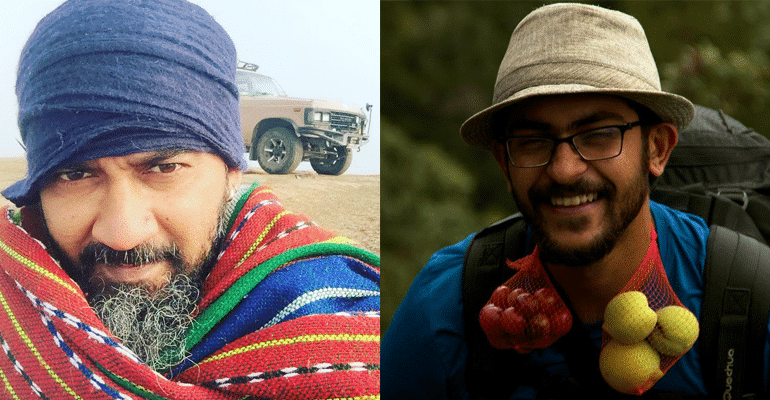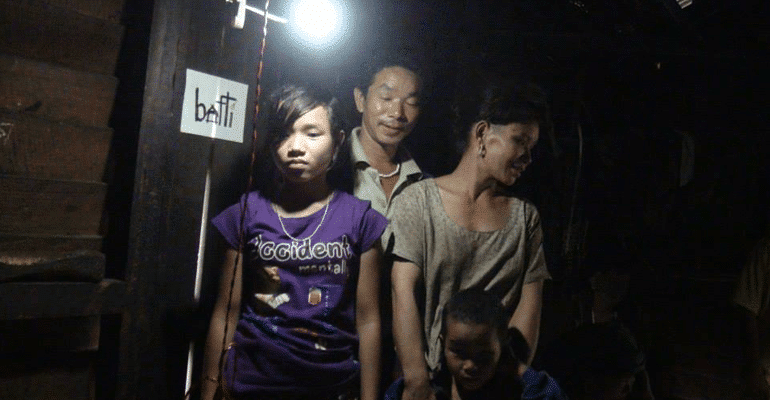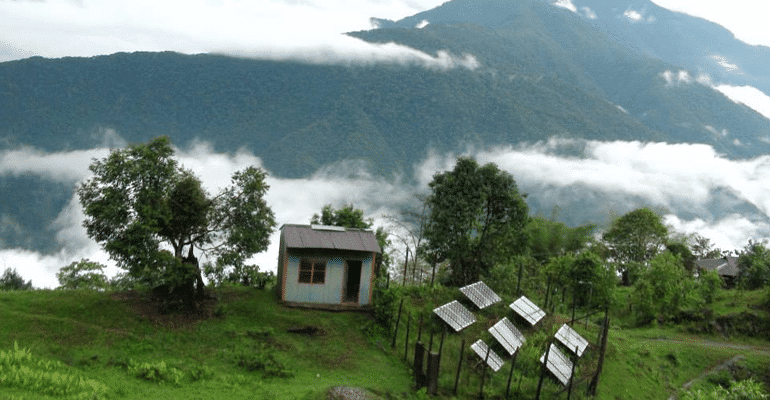“You don’t know what you have until it’s gone and it is exactly the same in the case of electricity,” says the 41-year old Merwyn from Mumbai.
While reliable electricity in rural areas still remains a distant dream for many, these two friends are on a mission to lit up the dark homes and lives in the far-flung areas of the country’s northeast region of Arunachal Pradesh.
Life Beyond Numbers got in touch with the founding member of Further and Beyond Foundation, Merwyn Coutinho, who along with his friend and co-founder Rajiv Rathod initiated the Batti Project to kindle the dark world of the tribals in Arunachal Pradesh (AP) by providing them with solar-powered lights.

The Batti Project happened accidentally. Eight years back, two friends and fellow travelers, Merwyn and Rathod went on an impromptu 6-day trek. But the duo hardly thought that they will end up impacting 1600 lives by lighting 434 houses in 41 villages across 3 districts of Arunachal Pradesh.
Batti Project – A journey from dark to light
“I have been in the corporate world for 14 years and after I realized that it is just a maddening rat race, I quit the corporate life to lead a nomadic life. I have been traveling since 2010 and my format was no plan, no timelines, no destinations,” recalls Merwyn.
It was in the first few years of his traveling in the north-eastern part of the country when Merwyn came across numerous villages that were struggling to survive due to the absence of light and one such village was Gandhigram village in the Changlang district of Arunachal Pradesh.
“This part of the country gets dark around 5 o’clock in the evening and therefore the people struggle to wind up their household chores like cooking and cleaning after nightfall. Similarly, it is difficult for students to study and therefore when the sky is dark, people either start gathering around the fire or they borrow torches or other equipment from people like us,” narrates Merwyn to LBN.
Overwhelmed by seeing people living in darkness, Merwyn came out of the region, connected with his friends, did his research and came out with the idea of installing solar-powered lights in these villages. For the wider outreach, he shared a post on Facebook informing people about the initiative and slowly help started pouring in.
“It took us two days for our team to walk through the villages, putting up wires and batteries before the installations can take place. Also, people here were so alien to the concept of the gadget that we had to teach them the use of a switches and use of this equipment and this is the reason we started Batti Project on a very low key instead of blasting the news everywhere, because we didn’t know what was coming forward,” mentions Merwyn.

When one village got lit up in the night, people from other villages approached them while they were coming back from trekking and asked: “when can we get ours?”. “They actually thought we were here on behalf of the government and it was our responsibility to put the light. I couldn’t deny that I couldn’t give you light, so we continued it since then.”
Currently, they have teamed up with Technical University of Munich (TUM) to light up the 50-student government primary residential school of Jumupani village in Lower Dibang Valley district. “As we speak the team is working on this project. We are creating a power system that will be independent, can be run with hydel and solar energy. The best part is this will be managed entirely by the school and the communities around them,” he adds.
The students belong to this same school, who were the victims when the suspension bridge they were crossing, collapsed in 2017.
Power saved is power generated
According to a report published in BBC, a village is considered electrified if 10% of its homes and all public buildings are connected to the grid. No wonder, the World Bank figures show around 200 million people in India still lack access to electricity.
“When you have 24/7 access to electricity in the city, you start taking it for granted and fail to realize the more you waste energy, someone else loses access to it as a consequence of your actions. I believe this is the new world problem where we have so much that we forget the focus on little yet significant things in life, which is essential for the people around us,” says the founder.

Merwyn and his team are now addressing their basic electricity needs so that they don’t have to depend on their only source of light which is fire. “We didn’t want to intervene much in a tribal environment because they already have a very sustainable way of life. They perform numerous animal-related rituals so light in the form of fire is very important for them and therefore, all the work happens around the fire.”
Creating awareness
Funding is always a challenge for this NGO. People here are unemployed and mostly depend on farming and hunting for their food and because of not having access to electricity, many villagers are moving out of the region in search of a better life.
“Without light no activities can be done right and when they move to the city and see light and technology everywhere, they make themselves believe that their life will change for good but when they couldn’t find a job and they need food and house to survive, things around them starts to crumble,” tells Merwyn.
A few years back, the foundation has earned themselves 80G certification and therefore, they are looking forward to CSR programs taking part to support this noble cause. “We are very transparent about our objective. Even though we are seeking public help now, we are always open to government-sponsored schemes,” he says.
We cannot just go to people and simply ask for money. People need to connect with the issue and understand the problem their fellow citizens are facing. “I didn’t opt for government help because their official data already showed that all the villages were electrified. So, instead of arguing about it, we involved the public and saw how beautifully we can raise funds,” mentions Coutinho.
Apart from raising 3.5 lakhs from a crowdfunding platform, the team also started ‘Ride to Light’, charity cycle ride program that urges people to raise certain amount to enrol in the cycling race and in return the participants get to ride across the eastern Himalayas to experience the tribal cultures, landscapes, and areas in need of light.
In 2016, the program also involved Tine Mena, who is Northeast’s first woman to scale the Mount Everest.
The NGO has also started an electronic waste program, where e-waste gets collected from the city and the team works with authorized recyclers to generate funds for the initiative. Coutinho mentions, “the community-based models on waste management help the villagers in AP to manage their own waste and recover useful materials that they were throwing away previously.”
You too can bring light to a house
“I want young people to be sensitive about things around them and this can be only done by showing them how the electricity is generated, distributed and what happens when I don’t consume so much because we live by example. By using renewable sources of energy, you can help people as well as take care of your environment at the same time,” says Merwyn.

Sharing one beautiful incident from his journey, Merwyn says, “when we lit the first house, there was a 90-year old woman whom we taught the use of solar lights. On our next visit, when we asked, why doesn’t she switch off the light when she goes to sleep, the lady said, ‘I never had light in my entire life and now that my sons have brought me light, why shall I switch it off?’ This showed us how much value these people have for light and it was a life-changing experience for us and it inspired us to work harder,” he adds.
Even though the Batti Project started in 2012, the organization got registered as an NGO in 2015. “I still don’t know why we need to register ourselves to do something to do good work. But, nonetheless, that’s how the system is and we are focused on doing the work in the most effective manner.”
With a goal to electrify 1500 homes in East Kameng, last year the foundation had lit up hundreds of houses in Lower Dibang Valley and another hundred in East Kameng’s Lada circle.
It takes only 10,000 rupees to light up a home in the villages of north-east India. Will you step forward and donate for the change?

